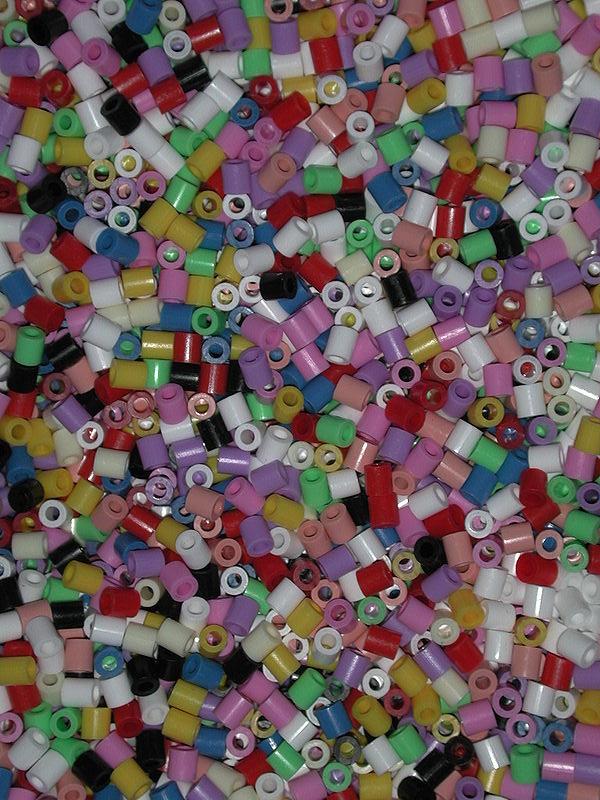Falling beads
Problem
Suppose that you have a large number of knitting needles and thousands of beads which can slide along needles without friction. All beads are released from rest at the same time from a point A to slide down the needles.
- Find a shape which is formed by the beads after time $t$.
- Describe how this shape is changing with respect to time.

Extension: In a real situation there will a friction force. The coefficient of friction is $\mu$. Suppose it is not dependent on the speed of a bead. Find the shape of beads after time $t$ and describe how it is changing.
Getting Started
It might help to express the distance traveled by a particular bead in the Cartesian coordinates in order to describe what's going on.
Extension: Think about the symmetry and the possible shape of beads.
Student Solutions
First of all let's choose a convenient Cartesian coordinate system as shown in the picture and suppose that the bead which is sliding through the needle inclined at an angle $\alpha$ to x-axis is at distance $r(t)$ from the origin.
The gravity force is acting on the bead and it makes the bead accelerate along the needle. Write II-Newton's law in the direction along the needle and in the direction perpendicular to the needle.
$$ma = mg\sin(\alpha)$$
$0 = N - mg\cos(\alpha)$ where $N$ is a reaction force.
Beads start from rest, so $r(t) = \frac{at^2}{2} = \frac{g\sin(\alpha) t^2}{2}$.
Change the polar coordinates to Cartesian coordinates by substituting $r = \sqrt{x^2 + y^2}$ and $\sin(\alpha) = \frac{y}{\sqrt{x^2 + y^2}}$.
$$\sqrt{x^2 + y^2} = \frac{y}{\sqrt{x^2 + y^2}}\frac{gt^2}{2}$$ Multiply both sides by $\sqrt{x^2 + y^2}$ and complete the square.
$$x^2 + \left(y -\frac{gt^2}{4}\right)^2 = \left(\frac{gt^2}{4}\right)^2$$
- The shaped formed by beads after time $t$ is a circle of radius $\frac{gt^2}{4}$ with centre coordinates $\left(0, \frac{gt^2}{4}\right)$.
- From the previous answer we deduce that there is a circle whose centre is falling with the acceleration $\frac{g}{2}$ and this circle is expanding with the same acceleration. A picture shows the shape of beads after time $0.5\textrm{ s}$, $0.75\textrm{ s}$, $1\textrm{ s}$, $1.25\textrm{ s}$, $1.5\textrm{ s}$, $1.75\textrm{ s}$, $2\textrm{ s}$.Image
Extension: Now we have a friction force due to sliding. We modify our previous equations:
$$ma = mg\sin(\alpha) -\mu N$$
$0 = N - mg\cos(\alpha)$ where $N$ is a reaction force.
$$\therefore\qquad a = g(\sin(\alpha) - \mu\cos(\alpha))$$ It is important to notice that if $a < 0$ then the bead is not even starting to slide. Thus, the beads will slide for $\alpha$ from $\tan^{-1}(\mu)$ to $(\pi - \tan^{-1}(\mu))$. To simplify the situation, notice that the shape will be symmetrical in the y-axis. Thus, we need to analyse what happens for $\alpha$ from $\tan^{-1}(\mu)$ to $\frac{\pi}{2}$. $$r(t) = \frac{at^2}{2} = (\sin(\alpha) - \mu \cos(\alpha)) \frac{gt^2}{2}$$ Change to the Cartesian coordinate system $x^2 + y^2 = \frac{gt^2}{2} (y - \mu x)$ for $\frac{\pi}{2} > \tan^{-1} (\frac{y}{x}) > \tan^{-1} (\mu)$. Complete the squares to get
$$\left(x+\frac{\mu gt^2}{4}\right)^2+\left(y-\frac{gt^2}{4}\right)^2=\left(1+\mu^2\right)\left(\frac{gt^2}{4}\right)^2\;.$$ It is easier to plot a whole circle and then to take a suitable arc. Similarly, to reflect a circle in y-axis change $x$ to $-x$ then we have an equation $$\left(-x+\frac{\mu gt^2}{4}\right)^2 + \left(y - \frac{gt^2}{4}\right)^2 = \left(1+ \mu^2\right)\left(\frac{gt^2}{4}\right)^2$$ and we take a suitable arc again. Let's take $\mu = \frac{\sqrt3}{3}$ then $\tan^{-1}\left(\frac{\sqrt3}{3}\right) = \frac{\pi}{6}$. We plot circles which help to show how the shape of beads in red changes. These graphs represent the shape of beads after time $0.5\textrm{ s}$, $0.75\textrm{ s}$, $1\textrm{ s}$, $1.25\textrm{ s}$, $1.5\textrm{ s}$, $1.75\textrm{ s}$, $2\textrm{ s}$. Circles are traveling along green lines which equations can be found knowing that the coordinates of center is $\left(\frac{\mu gt^2}{4}, \frac{gt^2}{4}\right) = \frac{gt^2}{4}\left(\mu, 1\right)$ and $\frac{gt^2}{4}\left(-\mu, 1\right)\;.$
To sum up:
- The shape of beads after time $t$ is an union of two arcs.
- Centre of circles are traveling with $\frac{g}{2} \sqrt{1+\mu^2}$ acceleration and expanding with the same acceleration.
